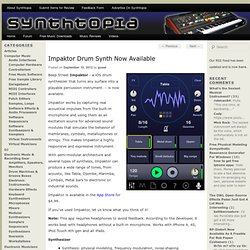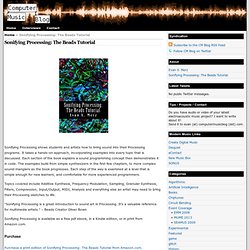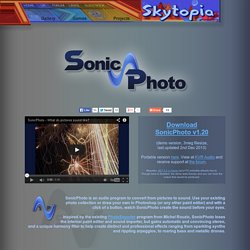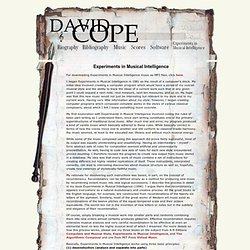

Impaktor Drum Synth Now Available. Beep Street Impaktor - a iOS drum synthesizer that turns any surface into a playable percussion instrument. – is now available.

Impaktor works by capturing real acoustical impulses from the built-in microphone and using them as an excitation source for advanced sound modules that simulate the behavior of membranes, cymbals, metallophones or strings. This makes Impaktor a highly responsive and expressive instrument. With semi-modular architecture and several types of synthesis, Impaktor can produce a wide range of tones, from acoustic, like Tabla, Djembe, Marimba, Cymbals, Metal bars to electronic or industrial sounds.
Impaktor is available in the App Store for $4.99. If you’ve used Impaktor, let us know what you think of it! Note: This app requires headphones to avoid feedback. Synthesizer Synthesis: physical modeling, frequency modulation, noise shapingSemi-modular architecture; 2 modules with configurable routing2 modulation sources: velocity and lfo-envelope. Recorder. Soundation — Make music online. Vintage On The Cheap. There's no doubt that these days software is king.

And why not? It costs a fraction of what hardware does, the sound quality is improving all the time, and you can literally fit your entire studio in a laptop bag. But for all its distinct advantages, there are some areas where software falls short for synth geeks. It's not really collectable. It has a far more limited lifespan than hardware given how quickly operating systems change. Unfortunately, vintage hardware doesn't usually come cheap and this can be a barrier that prevents a lot of electronic musicians from giving one of these old beasts a try. Casio never really got a fair shake with the professional music market. I'll grant you that Ensoniq is not a name you generally associate with 'classic' synths, but for the life of me, I'll never understand why the ESQ-1 isn't more popular on the used market.
This one can vary a LOT in price, so it pays to shop around and wait for a deal. So there's a handful to get you started. Synthesizer and electronic music news, synth and music software reviews and more! SYNTH ZONE - MIDI, Synthesizer & Electronic Music Production Resource Guide. Music Generators. Sonifying Processing: The Beads Tutorial. Home » Sonifying Processing: The Beads Tutorial Sonifying Processing shows students and artists how to bring sound into their Processing programs.

It takes a hands-on approach, incorporating examples into every topic that is discussed. Each section of the book explains a sound programming concept then demonstrates it in code. The examples build from simple synthesizers in the first few chapters, to more complex sound-manglers as the book progresses. Each step of the way is examined at a level that is simple enough for new learners, and comfortable for more experienced programmers.
Photosounder.com - Image-sound editor & synthesizer. SonicPhoto - Convert pictures to sounds! Using SonicPhoto is simplicity itself.

You can often achieve effective results by merely clicking "Load picture... " at the top left, and then click the green button "Create or Play sound". Following that, you might change one of the numerous slider options or finish off by saving the sound. For first time users, make sure you check out the inbuilt preset examples ("Choose a preset! " at top left) to see what you can achieve! Buzzmachines.com. Praat: doing Phonetics by Computer. Main. For downloading Experiments in Musical Intelligence music as MP3 files, click here.

I began Experiments in Musical Intelligence in 1981 as the result of a composer's block. My initial idea involved creating a computer program which would have a sense of my overall musical style and the ability to track the ideas of a current work such that at any given point I could request a next note, next measure, next ten measures, and so on. My hope was that this new music would not just be interesting but relevant to my style and to my current work. Having very little information about my style, however, I began creating computer programs which composed complete works in the styles of various classical composers, about which I felt I knew something more concrete.
My first exploration with Experiments in Musical Intelligence involved coding the rules of basic part-writing as I understood them, since part writing constitutes one of the primary superstructures of traditional tonal music.